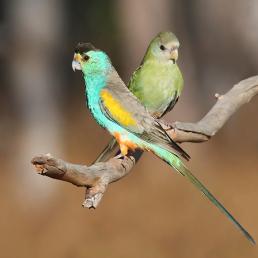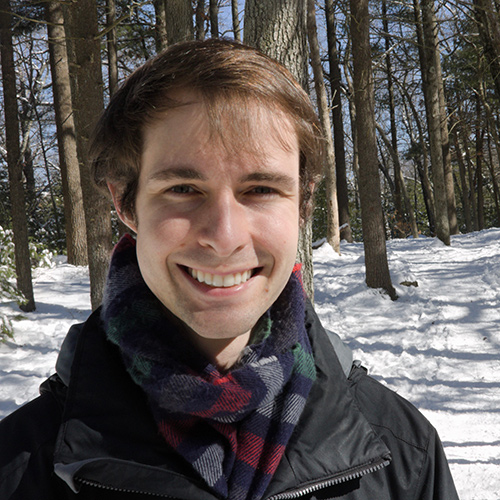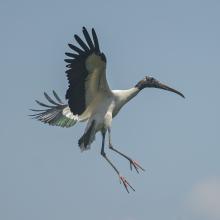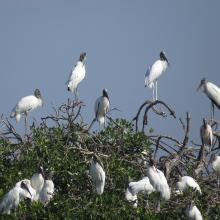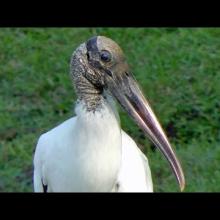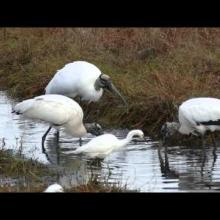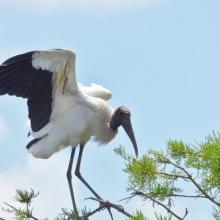

Join BirdNote tomorrow, November 30th!
Illustrator David Sibley and actor H. Jon Benjamin will face off in the bird illustration battle of the century during BirdNote's Year-end Celebration and Auction!
With their bare heads, long legs and massive bills, Wood Storks seem to have flown out of a fairytale — but in the American South they’re a real-life part of the ecosystem. Developers drained large areas of wetlands, causing the Florida Everglades population to decline to just 5,000 breeding pairs in the 1970s, placing them on the endangered species list. Habitat protection and restoration efforts have helped Wood Storks begin recovering, although they still struggle to find suitable breeding habitat in south Florida.
BirdNote®
Keeping Wood Storks on the Road to Recovery
Written by Conor Gearin
This is BirdNote.
[Wood Stork calls]
With their bare heads, long legs and massive bills, Wood Storks seem to have flown out of a fairytale — but in the American South they’re a real-life part of the ecosystem.
Here in the Everglades, Wood Storks nest alongside several other species on a tiny island in the center of a pond. The sounds of storks beating their big wings and clacking their bills together fills the air.
[Wood Stork bill clacks and wingbeats]
Wood Storks live throughout Latin America and the Caribbean. But in the U.S., they’re limited to parts of the Southeast with wetlands big enough to support breeding colonies. Developers drained large areas of wetlands, causing the Everglades population to decline to just 5,000 breeding pairs in the 1970s — placing them on the endangered species list.
Habitat protection and restoration efforts have helped Wood Storks begin recovering, although they still struggle to find suitable breeding habitat in south Florida. Meanwhile, some storks have expanded northward into the Carolinas.
[Wood Stork calls]
Continued protection of the storks’ wetland habitats is essential to making sure they can recover.
[Wood Stork calls]
For BirdNote, I’m Michael Stein.
This episode is sponsored by Joan Walsh and Dave Sibley to celebrate Dr. Margaret Rubega and the glorious Wood Storks.
[Wood Stork calls]
###
Producer: Mark Bramhill
Managing Editor: Jazzi Johnson
Managing Producer: Conor Gearin
Content Director: Jonese Franklin
Bird sounds provided by The Macaulay Library of Natural Sounds at the Cornell Lab of Ornithology, Ithaca, New York. Wood Stork ML135422 and ML135409 recorded by Mike Andersen and Martha Fischer.
BirdNote’s theme was composed and played by Nancy Rumbel and John Kessler.
© 2024 BirdNote March 2024
Narrator: Michael Stein
ID# WOST-01-2024-03-22 WOST-01
Reference:
https://birdsoftheworld.org/bow/species/woosto/cur/introduction
https://abcbirds.org/bird/wood-stork-2/
https://wusfnews.wusf.usf.edu/environment/2023-03-04/move-to-take-the-w…
https://www.biologicaldiversity.org/species/birds/wood_stork/status_stu…
